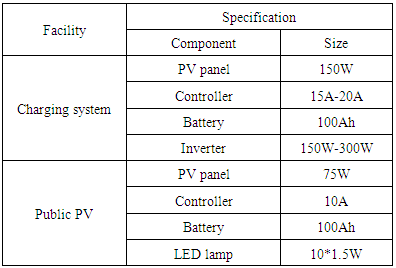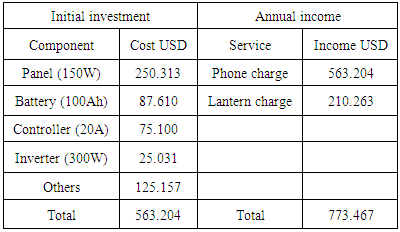-
Paper Information
- Paper Submission
-
Journal Information
- About This Journal
- Editorial Board
- Current Issue
- Archive
- Author Guidelines
- Contact Us
Energy and Power
p-ISSN: 2163-159X e-ISSN: 2163-1603
2017; 7(1): 10-21
doi:10.5923/j.ep.20170701.02

Technical and Socio-Economic Issues of Small Scale Solar PV Electricity Supply in Rural Ghana
Michael Acquah1, Wisdom Ahiataku-Togobo2, Ebenezer Ashie3
1Department of Civil and Public Law with References to the Law of Europe and the Environment, Brandenburg University of Technology-BTU, Cottbus-Senftenberg, Germany
2Department of Renewable Energy, Ministry of Power-MoP, Accra, Ghana
3Department of Energy and Finance, Energy Commission, Accra, Ghana
Correspondence to: Michael Acquah, Department of Civil and Public Law with References to the Law of Europe and the Environment, Brandenburg University of Technology-BTU, Cottbus-Senftenberg, Germany.
| Email: |  |
Copyright © 2017 Scientific & Academic Publishing. All Rights Reserved.
This work is licensed under the Creative Commons Attribution International License (CC BY).
http://creativecommons.org/licenses/by/4.0/

In recent years, off-grid small-scale renewable energy technologies, particularly, solar PV systems have emerged as the plausible intervening solution for rural electricity supply in Ghana. However, the emerging solar PV solutions are exposed to the problem of being sustainable: after government and developing partners pull-out and hand over project to local users, the project only last few years of their life span. To investigate into this problem, the paper adopts a community solar system, a national project meant to be adopted as a standard for rural electrification in Ghana, for evaluation. Principal objectives of the paper are to identify the potential technical and socio-economic barriers of solar PV rural electrification, access the relevance of small-scale solar PV solutions in rural livelihood and determine if the community solar system project is worth recommending as national standard for rural electricity supply. The evaluation results reveal that frequent damage of systems’ components, misuse of systems, inability of systems to meet rural electricity demand, and financial insecurity are the major factors that could offset the success of the community solar system project or similar small-sale solar PV systems for rural electrification solutions. We advocate that the community solar system project is worth recommending under critical design considerations. Finally, we conclude that small-scale solar PV solutions do not present complete solution to rural electrification; however, in the meanwhile, they are necessary as intervening solutions and play key role in rural development.
Keywords: Ghana, Rural electrification, Solar PV Systems, Sustainable development
Cite this paper: Michael Acquah, Wisdom Ahiataku-Togobo, Ebenezer Ashie, Technical and Socio-Economic Issues of Small Scale Solar PV Electricity Supply in Rural Ghana, Energy and Power, Vol. 7 No. 1, 2017, pp. 10-21. doi: 10.5923/j.ep.20170701.02.
Article Outline
1. Introduction
- Ghana’s electrification policy is pursued through a national electrification scheme (NES), which is meant to electrify all communities with population above 500 inhabitants by 2020 [1, 2]. One of the major challenges that confront the NES is extension of electricity to the rural areas. The challenge is of two folds: Firstly, grid electricity connection to the rural communities is extremely expensive due to lack of access roads, geographical remoteness, and settlement patterns of the rural communities. Secondary, low population rates coupled with high poverty levels of the rural populates make grid extension of electricity to the rural communities increasingly ineffective [2]. To tackle this problem, the government of Ghana (GoG) in collaboration with international organizations (e.g. United Nations Development Program-UNDP, Global Environmental Facility-GEF, Japan International Cooperation Agency-JICA) have opted for the provision of off-grid systems, mainly in the form of solar PV, as intervening solution for rural energy supply [3, 4].In the recent decade, the efforts on the advancement of solar PV systems have resulted in the introduction and implementation of valuable projects in the country. Some of the solar projects that can be mentioned includes PV street lighting, PV public systems (e.g. PV systems for schools and clinics), solar PV water pumping systems, PV lantern systems, and PV charging systems [4, 5]. However, it has been observed, over the years, that after developing partners pull-out and hand over project to local users, the projects only last few years of their expected life-span. This characteristic unsustainable problem associated with small scale rural electrification projects in Ghana has prompted this study to probe into the possible technological and socio-economic factors that may influence the successful implementation and development of such projects.In order to accomplish the stated task, the research adopts a community solar system (CSS) project, which involves solar PV systems for the provision of electricity in 20 island and isolated rural communities across Ghana. The adoption of the CSS project for this study is grounded in two major factors. One, the project involves small scale solar PV systems, which have emerged as dominant renewable energy technological options for rural electrification; and two, the CSS project has been developed as a standard solar PV system to be adopted for rural electrification in Ghana. Hence this paper will provide useful information on sustainable development of small scale solar PV systems as well as the plausibility of the CSS project for adoption as a standard system for rural electricity supply in Ghana. Thus the objectives of the paper are to evaluate and identify the potential technical and socio-economic barriers that are of significance hindrance to the successful implementation of small scale solar PV rural electrification project; and also assess whether or not the CSS project is worth recommending for further implementation (in terms of technological design, integration, usability, and financial stability) as a standard for rural electrification solutions in Ghana.The remaining of the paper is organized as follows. In the next section, we present a review of related works on renewable energy broadly from the context of Sub-Saharan Africa and specifically the Ghanaian context with a focus on solar PV. This is followed by the materials and methods section where an overview of the study area, details of the adopted solar PV project as well as the tools and methods employed are entailed. Section 4 presents the details of results and discussions. Finally, we conclude in section 5 with measures we consider necessary to ensure sustainable rural electrification solutions.
2. Overview of Related Works
- The issue of energy supply in Sub-Saharan Africa (SSA) needs urgent attention, particularly, with regards to rural electrification to ensure sustainable development. According to 2012 World Energy Outlook Report, the trend in electricity access in other regions such as developing Asia has high potential to improve remarkably. Forecast shows that the region is making significant progress towards improving electricity access from about 630 million people without electricity from 2010 to about 335 million in 2030, which would be about 50% improvement [6]. The situation is, however, different in SSA. Even though the region was ranked highest with record of 589 million people without electricity access in 2010, projections indicate that the situation could exacerbate to about 655 million people in 2030 due to fragility of intervening actions. The problem is worse in the rural areas where most of the people have never had access to electricity. According to UNEP, the rate of rural electricity access in the sub-region is only 8 per cent, whereas 85 per cent of the population rely on biomass for energy [6, 7].A dive into studies on the development of renewable energy (RE), however, indicate that the attempt to increase the share of RE is very high on the policy agenda of most leaders in developing countries, including SAA [7-11]. The new paradigm shift of policy agenda towards the development of RE in developing countries, especially in the Sub-Saharan Region is a step in the right direction. This is because the region is known to be rich in RE resources. Efforts to utilize the abundance RE resources for electricity supply, for instance, will among others lead to increased access of energy in the rural areas and reduce the huge gap between the urban and rural energy supplies. Additionally, a focus on renewables for energy supply in rural areas in the sub-region will reduce the overdependence on biomass, especially firewood and charcoal, and its associated devastating impacts on forest and the emissions of greenhouse gases.In order to turn the current RE policy aspirations of many Sub-Saharan countries into a reality, there are underlining multifaceted challenges that need to be addressed. Some of the challenges that have been identified in recent studies are: rural remoteness and accessibility, affordability, low population densities, low project profitability, fiscal deficit, over-dependence on subsidies, lack of access to affordable finance, bureaucracy, lack of consumer awareness, and high interest on credit facilities. Others include unsustainable policies, technology integration, societal receptiveness, lack of professionalism, misuse of materials, and ineffective energy infrastructures [9, 10, 12-15].Besides the general factors that confront the success of RE supply in rural SSA, it is also imperative to discern the situation in Ghana. Undoubtedly, the environs that influence renewable energy initiatives in rural Ghana are not much different from that of the sub-region. Hence it is important to recognize the fact that renewable solutions for rural energy supply in Ghana share similar characteristic challenges with those of the sub-region and other developing countries. According to the director of renewable energy, one of the major challenges that are hampering the success of Ghana’s RE campaign is frequent failure of systems. Most RE solutions, especially solar PV systems are received enthusiastically in the rural communities, system work very well within the first three years and then collapse after development partners pull-out. Curiosity into recent studies reveals technological issues such as technical immaturity, institutional inexperience, lack of skills, inadequate training, and high installation and maintenance costs as major barriers to RE development in rural Ghana [16, 17]. Besides the factors that are often categorized as technical issues, most of the RE challenges encountered in literature are socio-economically related. Common socio-economic challenges includes non-existence of market push strategies to promote adequate patronization of RE technologies; inadequate credit facilities coupled with lack of willingness to give loan due to high level of uncertainty and risk; low interest from the general public resulting in lack of competition; lack of human capacity in the rural communities, lack of skills and competency at the rural level due to low educational background, and persistent high poverty levels of the rural populates [15, 16, 18]. In addition to the technical and socio-economic barriers to RE development that we mostly encountered in literature, a recognition is given to other papers that have also identified significant barriers that are policy and institutionally related such as [17, 19].Regarding specific development on solar PV, most of the challenging issues are covered by papers that focus on REs in general. However, there are academic commitments on history, resources assessment, and policy advancement on solar PV development [17, 20]. There is also a notable advancement of studies on the emerging PV market regime as well as social and economic impacts, with specific attention on poverty alleviation [21-23]. In spite of the enormous academic efforts on RE development, specific factors that may have significant influence on the implementation of solar PV project have not received critical attention in recent studies. This knowledge gap is the focus of this paper. The paper endeavours to provide specific details of technical and socio-economic issues that may present considerable levels of influence on solar PV development. Moreover, this era has become concurrent with the proliferation of solar PV systems for electricity supply, hence, specific knowledge on factors that will inform sustainable solar PV development is very vital.
3. Materials and Methods
3.1. The Study Area
- The CSS project is in its second pilot stage and implemented across the whole country covering 20 rural communities from 13 districts and 7 regions in Ghana (Figure 1).
 | Figure 1. Map of Ghana showing 20 CSS pilot project sites |
|
3.2. The CSS Project
- The CSS project resulted from studies initiated since 2003. Due to institutional and structural challenges experienced in past renewable energy project, the GoG tasked JICA to conduct a master plan study to address the challenges in June 2003.The study recommended the introduction of ‘Human Resource Development for Disseminating PV Systems in the Republic of Ghana’. In addition, JICA also proposed the need to introduce sustainable models in PV for rural electrification. Subsequently, the CSS project was adopted based on the merging of ideology of the two complementary projects: the PV models for rural electrification as one part and human resource development scheme. The first pilot was conducted in 2009. After being revised, the second 20 pilot projects were planned around the country since 2011 [24].The project has two installations: (1) the public (school or clinic) PV installation, and (2) the community (charging service) PV installation as configured in Figure 2 below.
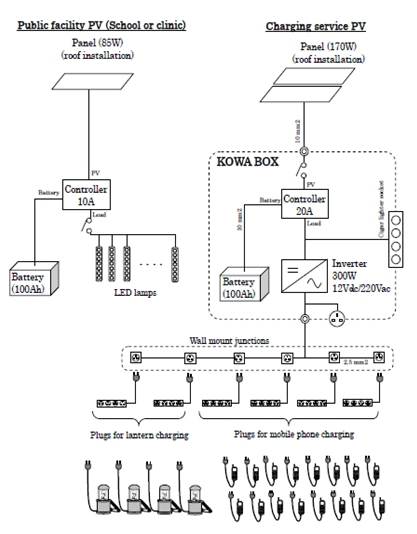 | Figure 2. Configuration of CSS for public and charging systems |
3.3. Specifications of the CSS
- The CSS model was designed as standard for rural electrification. Based on previous studies, it specifications are standardized as follows:1. Population of around 500 people is common in un-electrified communities;2. More than half of the population have mobile phones and need charging;3. Minimum requirement of CSS is to charge more than 50 mobile phones in a day;4. Charging of car batteries are possible and common battery size in rural areas is 50Ah;5. Charging of lanterns are not yet common in rural Ghana, however, they can be charged when there is less mobile phone charging demand.Based on these requirements, the CSS is specified as follows:Charging of mobile phonesBattery size of a mobile phone: 3.8V, 1.2Ah
 | (1) |
 | (2) |
 | (3) |
 | (4) |
 | (5) |
 | (6) |
 | (7) |
 | (8) |
|
3.4. Business and Financial Details of CSS
- Business feasibility of the CSS project in terms of cash flow is assessed to ascertain whether income from charging operations can cover necessary maintenance and operation costs and recover investment. The following is a feasibility study of the charging service in terms of cash flow.Assumptions made based on specifications and previous studies are:System size 150W; possible rate of charging:Mobile phones: 15/day;Lantern: 4/dayCharging fees: Mobile phone: 50pesewas/mobile phoneLantern: 70pesewas/lanternOperation days in a year: 300days/yearBased on these assumptions, annual income from charging is calculated as follows:
 | (9) |
 | (10) |
|
 | (11) |
|
3.5. Evaluation of the CSS Project
- The evaluation of the CSS project was achieved through interview with key stakeholders responsible for operation, maintenance and management of the systems in the communities as well as testing of the systems’ components. The evaluation was carried out with a team of experts from the Ministry of Energy and Petroleum (MOEP) as part of the ministry’s annual monitoring and evaluation exercise. The tools employed in the evaluation exercise are: Garmin etrex GPS tracker, a multi-meter, a voltage detector, an evaluation guide questionnaire, and a camera.The evaluation of the systems and their components performance was conducted through interviews, system inspection, and testing of system components. System operators were interviewed one-to-one with open-ended evaluation guide questions in each community. However, in some cases, the community leaders gave the team opportunity for group discussions. The target interviewees from each community were the community agent (CA), the concessionaire, and community members that were randomly selected. In the absence of the CA or concessionaire, a care-taker of the system was interviewed. The evaluation guide questions were structured into 4 thematic areas covering system working status, system’s components performance, business operation performance, and significance of the SCC project to the community. The entire evaluation proceeded as depicted in Figure 3.
 | Figure 3. Schematic representation of the CSS evaluation procedure |
4. Results and Discussions
4.1. Technical Aspect
- Broad overview of the working status of the CSS project in 12 communities evaluated is presented in Figure 4. Only the results of 12 communities are presented. The entire system of one community was stolen, whiles in another community, the team was denied access to the systems for evaluation.
 | Figure 4. Perfomance of CSS for charging and public systems |
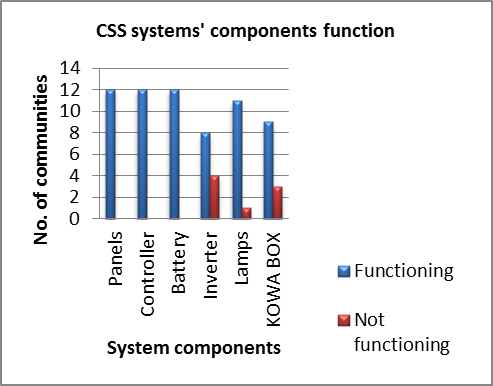 | Figure 5. Relative performance of CSS’s components |
 | Figure 6. Charging of gadgets in a community |
4.2. Economic Aspect-Business Operation
- According to the financial feasibility estimate of the CSS business operations, the project is supposed to generate an annual net income of about GH¢1000.00 (250.313 USD). The evaluation results of the financial performance, however, show that the annual net income estimate is relatively high whereas the annual expenditure, which was estimated at GH¢300.00 (75.1 USD), is extremely low due to frequent inverter damages and subsequent servicing charges. This shows that the overall cash flow estimate of the project has significant inconsistencies and need to be reconsidered. Although our assumptions and analysis are entirely based on the financial records from charging operations presented, we recognize the possibility of inconsistencies because there was no robust means of monitoring the cash flow of the business operation in the CSS project. This is a key challenge that was observed from the business operations and poses a significant question on how cash flow from small scale solar PV business operations could be controlled in rural areas. Out of the 12 communities evaluated, 6 communities presented financial records of daily charging services without details on expenditure. The business and financial performance aspect of the project is very crucial as it is the key factor determining the capacity of the system to sustain itself. It is also the most important factor to ascertain whether or not the whole CSS concept is feasible in the Ghanaian rural settings. However, the cash flow records of the six communities do not reflect a sustainable financial image of the project. The annual net annual income recorded by the two communities (Njare and Bomigo) in 2012 operational year (Figure 7) cannot be relied on because they failed to show any records on expenditure. On the other hand, Danlaidi and Kabiti recorded higher expenditure than gross income generated, which resulted in net annual losses respectively. This implies that financially, such systems in Danlaidi and Kabiti cannot be self-sustainable with regards to any future eventualities. On the positive side, Kracheibi recorded a sound net positive income (GH¢861.60/215.67 USD). However, this is below the estimated annual benefit (990 ≈ 247.81 USD) from the project’s business operations. Nevertheless, the effort of Kracheibi is significant evidence that the CSS business operation could be highly profitable with effective operation and management efforts.
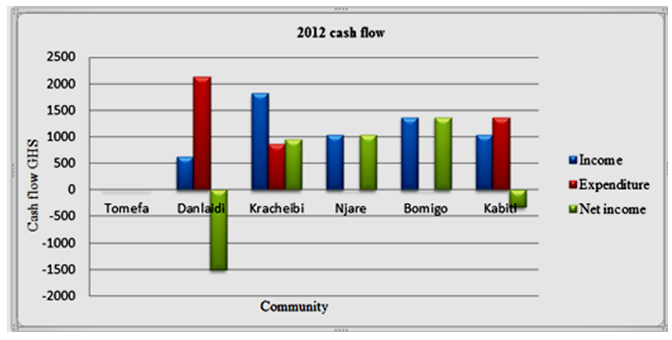 | Figure 7. Cash flow of CSS charging operations in 2012 |
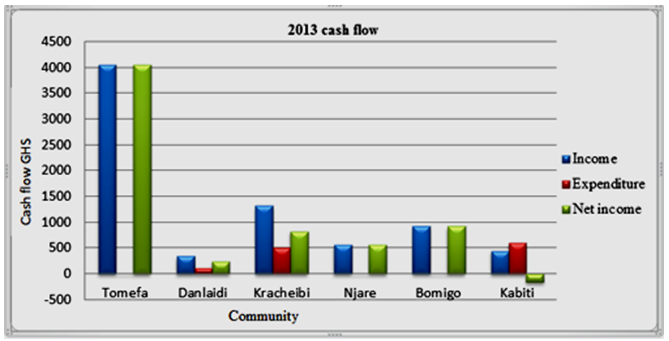 | Figure 8. Cash flow of CSS charging operations in 2013 |
4.3. Social Aspects-CSS Project Significance in Rural Livelihood
- In order to assess the significance of small scale renewable energy (SSRE) projects in rural development, the CSS project was also subjected to some extent of community impact assessment in the evaluation exercise. This was achieved through additional interviews with randomly selected community members, experts from from DAs, the CAs and the Director of Renewable Energy from the MOEP to retrieve information pertinent to ascertaining the relevance of the CSS and such SSRE projects in rural livelihood of Ghana. The relevance of the CSS project was assessed based on the following 4 parameters: system performance, system acceptance, system’s electricity expectations, and system recommendation. The result of the analysis is depicted in figure 9.
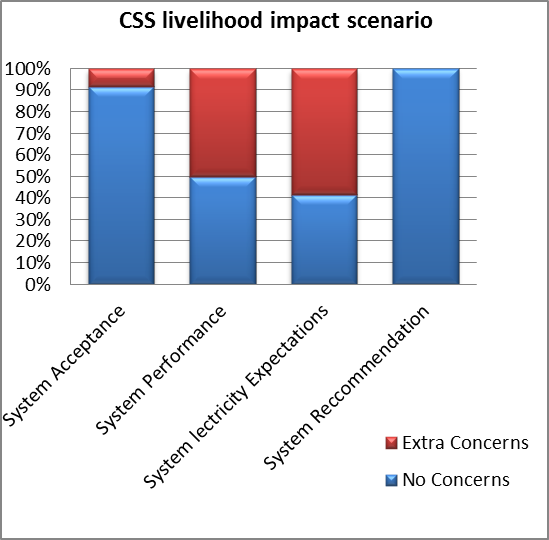 | Figure 9. Significance of CSS in rural development |
5. Conclusions and Recommendations
5.1. Conclusions
- The CSS project with the complementary human resource development component provides strategic solutions to the problems of rural electrification in Ghana. However, the evaluation results of the project indicate that there are important factors that can significantly hinder the sustainability of the CSS project and other similar small scale rural electrification solutions if they are not adequately addressed.Firstly, the technical evaluation results show that the CSS project has relatively simple design with simple components and operation. This makes the project design user friendly with high integration potential in the Ghanaian rural settings. This is justified by successful operation of the project so far and respondents’ high level of confidence and satisfaction with the system performance as well as the communities’ appreciation of the system. However, the frequent damaging of inverters is alarming. As it is seen in the case of four communities, the inverter problem ceased four charging systems from operation. This problem is appropriately classified in this paper as ‘frequent failure of system component’ and is closely linked to the quality of system components or misuse of the system.Another technical challenge identified is overloading of the system where other electrical appliances with capacities higher than the nominal capacity of the inverter, such as water heater and pressing iron, are used. This problem is as a result of knowledge gap, which is closely linked to the effectiveness of the human resource development component of the project. Since the complementary model of the project was meant to adequately train and equip local personnel with requisite knowledge and skills to operate the system, such operational inadequacies should have been dealt with. Regarding the economic aspect of the project, the evaluation results also uncovered important factors that could offset the sustainable concept of the project if they are not addressed. First, there is inconsistency in the cash flow estimations of the projects, which is highlighted by net annual income and expenditure that are respectively far below and extremely higher than expectations. Here, it is important to mention that we recognize the possible argument that the low financial performance could as well be attributed to other factors such as lack of close monitoring of charging operations. However, we assume that every aspect of the CSS project including management function as expected and takes care of such possible contributing factors. In general, the business operations of the project is characterized by poor bookkeeping record as only 6 out of the 12 communities presented financial records without details on expenditure. Clearly, this is an evidence of lack of regular monitoring of charging services. Additionally, we recognize a significant depreciable variation between the 2012 and 2013 business operation years. This does not really matter if the income generated could still offset expenditure to maintain the systems. However, the huge cash flow difference does matters on the point that it signals a decrease in appreciation and patronization of the system, which has been found to contribute to small scale projects often being abandoned in few years after their implementation.In spite of these concerns, we are confident that the CSS project is financially viable and could be self-sustaining from its business operations. This is based on the fact that the business operations are not profit oriented but for the purpose of maintaining the systems from damages and repair services by making it self-sustaining. In order to realize this, however, it is important that managerial efforts are raised, particularly on monitoring of charging operations. The business feasibility from charging operation also presents suitable grounds and opportunity for private investors. Since there are thousands of un-electrified rural communities, there exist a huge business potential for charging of mobile phones and lamps that would also induce some level of employment in the rural areas. The last aspect of the evaluation on the significance of the CSS project in rural livelihood showed that the project is highly welcomed in all the beneficiary communities. However, besides the concerns that were duly raised by CAs and concessionaires regarding the frequent breakdown of inverters in the charging system, they specifically pose a characteristic challenge to the success of the CSS charging system. Moreover, most communities expressed concerns on the inability of the system to supply adequate electricity to support social life. This implies that expectations are higher than what the system could actually deliver. This is the major factor that is found to likely contribute to a decline in appreciation and patronization of the CSS project or other similar small-scale solar PV project that are often delivered to the rural populates with the notion of solving rural electricity needs including political promises.Finally, we advocate that the CSS project is worth recommending for further implementation, however, to be adopted as a standard system for rural electrification solution, the design capacity need to be critically considered to improve its robustness and electricity supply capacity. In a nutshell, we conclude that the CSS project and other similar small scale renewable energy rural electrification solutions do not offer significant opportunity to improving rural livelihood and do not abridge the energy poverty gap between the cities and the rural communities. However, in the meanwhile, they are necessary as intervening solutions and play key role in rural development.
5.2. Recommendations
- In the context of the issues identified in this paper as issues of potential significant hindrance to the sustainability of the CSS project similar small scale renewable energy projects, the following are some remediating steps that the study proffers to overcome those potential barriers. Regarding the technical issues of ‘frequents system component failure’ and ‘misuse of the system’, it is recommended that the quality of system components and source of manufacturing be duly considered to ensure that materials and components of good quality and source are purchased in future developments to ensure durability of the components and sustainability of the entire system. If possible, it would be necessary that manufacturing of components be customized in future development to produce components with greater resilience and self-protection capacities to meet the hash and possible operational eventualities in rural settings. A possible solution would be to introduce models that would have an in-built shunt to regulate voltage flow. This would prevent the use gadgets such as iron and water heater.It is also plausible that the design and operational capacity of the charging system and components be adjusted to increase the overall voltage that would cater for population expansion. The current design of the CSS project would be inconsistence with future population expansions since the project has a lifespan of 20years. In this regard it is necessary that attention is given to population expansion and possible increase in electricity demand when designing small scale rural electrification project. Operational irregularities could duly be addressed with regular monitoring and supervision of the system. Continual training and support for the CAs, concessionaires and local operators will increasingly broaden their knowledge and build their competency, which would contribute to responsible operation of the system.The major financial issues discovered in the study are mainly found to be managerial lapses. Although this paper does not cover the management aspect of the CSS project, there is a well-defined top-bottom management structure, from the ministerial to the communal level that is responsible for the management of the CSS project. In order to ensure financial stability and the self-sustaining concept of the project, it is strongly recommended that managerial efforts are intensified. This is absolutely important, particularly, at the rural level to monitor charging and business operations to improve and ascertain the credibility of bookkeeping. Subsequently, we strongly recommend further studies on the effectiveness of small scale electrification projects management.In view of peoples’ over-expectation from small scale electrification project, it is absolutely important that beneficiaries of such rural electrification solutions are well educated to bring them to a close level of understanding. This would help to ensure that rural folks do not receive such project with extremely high expectations and then abandon the project in in no time when their expectations are not met. Finally, we recognize that models with higher electricity capacity would be relevant to enhance or improve rural social life. One of the means will be to lay the grounds that will attract private investors who could introduce current technologies and also tap the advantage of competitiveness in the emerging solar PV market to sustainably tackle the rural electrification problem in Ghana.
ACKNOWLEDGEMENTS
- The authors are thankful to the Ghana Ministry of Energy, which was then the Ministry of Energy and Petroleum, for availing the community solar system project for the evaluation exercise. We also thank the Renewable Energy Department of the Ministry for their technical and financial supports that made the evaluation exercise possible. Finally, we are particularly grateful to Mr. Joe Nyamorde and Mr. Dennis Turkson from the Renewable Energy Department for their immense technical contributions in the evaluation exercise.
 Abstract
Abstract Reference
Reference Full-Text PDF
Full-Text PDF Full-text HTML
Full-text HTML
